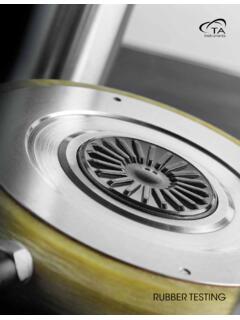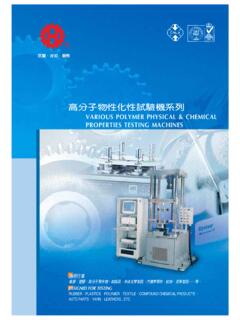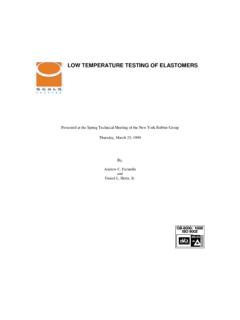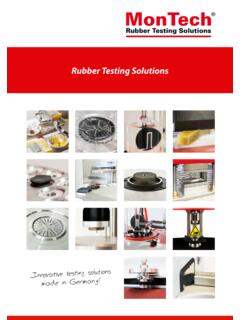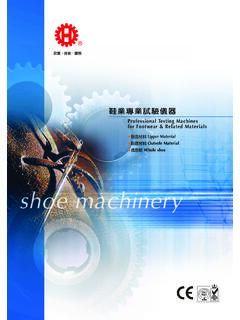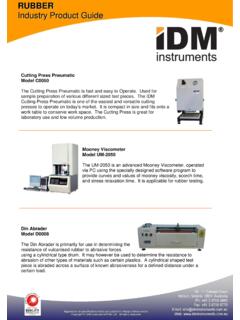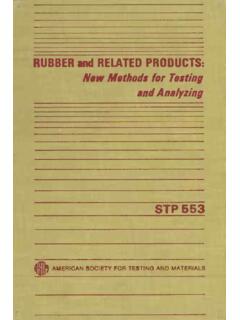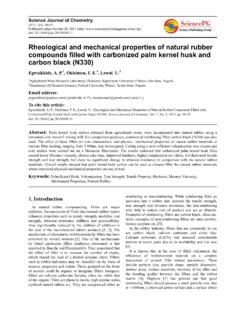Transcription of Evaluation of the Mooney Viscosity of Natural …
1 Evaluation of the Mooney Viscosityof Natural rubber by Near- infrared SpectroscopyCelio Pasquini and Fernanda Crivelari FigueiredoInstituto de Qu mica, Universidade Estadual de Campinas,Campinas SP, BrazilBenildes PrinceBRASLATEX, Indu stria de Come rcio de Borrachas Ltda.,Ba lsamo SP, BrazilAbstract:The direct near- infrared spectroscopic reflectance measurements of prevul-canized Natural rubber (brown crepe) was employed for determination of its Mooneyviscosity. NIR reflectance spectra were obtained for a total of 100 samples whoseMooney Viscosity (VM in the range 68 95 units) have been determined by thestandard reference procedure using a commercial computerized Mooney samples were employed as the raw material or were treated to achieve betterhomogenization. A Fourier transform near infrared (FT-NIR) spectrophotometer wasemployed, and the reflectance spectra were obtained with resolution of 4 cm21in therange 4000 10,000 cm21as an average of 75 scans.
2 The samples were split in a cali-bration set containing 70 samples and in an external validation set consisting of theremaining 30 samples. The calibration and validation spectra sets were treated tocorrect for baseline shift, further transformed by first derivative and finally modeledby partial least squares (PLS) employing four latent variables. The model wasevaluated with the external sample test set, and a RMSEP of and units ofMooney Viscosity were obtained for homogenized and nonhomogenized samples,Received 27 November 2004, Accepted 18 March 2005 This paper was by special invitation as a contribution to a special issue of the journalentitled Quantitative Vibrational Spectrometry in the 21st Century. This special issuewas organized by Professor Miguel de la Guardia, Professor of Analytical Chemistry atValencia University, correspondence to Celio Pasquini, Instituto de Qu mica, UniversidadeEstadual de Campinas, Caixa Postal 6154, CEP 13083-862, Campinas SP, : Letters, 38: 741 748, 2005 Copyright#Taylor & Francis, 0038-7010 print/1532-2289 onlineDOI: The NIR method is capable of determining the Mooney Viscosity in fewminutes in the non-pretreated sample with an error that is satisfactory for qualitycontrol of Natural rubber destined for automobile tire.
3 Mooney Viscosity , Natural rubber , NIR spectroscopy , reflectancespectroscopyINTRODUCTIONThe elastic properties of Natural rubber derive mainly from the characteristicsof the polymeric isoprene in itscisisomer (cis-1,4-polyisoprene) whosestructure is shown in the inset of Fig. 1. The less symmetrical structure ofthis isomer makes crystallization difficult and is responsible for theamorphous, flexible characteristics of the Natural rubber has found an enormous number of applications in indus-trial products; notable among these is its use for making automobile Natural prevulcanized latex (brown crepe) is evaluated for its qualityand adequacy for various end uses. The Mooney Viscosity is one of themore relevant parameters considering the destination of the Natural rubberfor tire production.
4 Mooney Viscosity is defined as the shearing torqueresisting rotation of a cylindrical metal disk (or rotor) embedded in rubberwithin a cylindrical cavity. The dimensions of the shearing disk viscometer ,test temperatures, and procedures for determining Mooney Viscosity areFigure selected reflectance spectra of raw samples, after baseline offsetcorrection, presenting Mooney viscosities in the range investigated in this work. Thenumbers represent the approximate Mooney Viscosity of each sample. Inset: Chemicalstructure of the Natural rubber :cis-1, Pasquini, F. C. Figueiredo, and B. Prince742defined by the ASTM test method D1646-04.[1]This parameter is measured ina heavy and complex mechanical instrument at high temperature (1008C)where the resistance of a material to flow under stress is accessed byrotating a metallic disk on a rubber sample and measuring the torquenecessary to keep the rotation at 2 revolutions per minute after a fixed timeinterval (5 to 10 min).
5 Prevulcanized Natural rubber presents Mooney viscosities in the range60 90 and the acceptable range for use in tire manufacture is between 75and 80. The Mooney viscometer is an instrument specially constructed todetermine the Viscosity of the Natural rubber . Computerized instruments canobtain the Viscosity measurement with repeatability within 3 units althoughthe mean standard deviation for an average value of the same piece ofnatural rubber can reach about 5 units. This last fact is due to the hetero-geneous characteristics of the Natural prevulcanized rubber . The measurementis time consuming (about 20 min for a single measurement), and the instru-ment requires constant maintenance. Furthermore, the sample needs to behomogenized by being preprocessed with a heated cylinder, an operationthat requires an additional 15 Mooney Viscosity can be associated with the molar mass of thepolymer chain.
6 The average molar mass obtained by gel permeation chromato-graphy (GPC) has been proposed for determination or has been associatedwith the Mooney Viscosity .[2,3]However, the proposed method requires theuse of a GPC instrument and is another time-consuming technique thatprevents rapid,in situdetermination of the Mooney (NIR) spectroscopy has been used to determine bulk prop-erties of a variety of samples, including artificial polymers. The informationpresent in a NIR spectrum can be related to crystallinity,[4]molar mass,[2 5]and Viscosity [6 10]of polymeric materials. However, the use of NIR spec-troscopy for determination of Mooney Viscosity of Natural rubber has notyet been described in the work aimed at the development and Evaluation of the use of directNIR reflectance spectral measurements for determination of the Mooneyviscosity of Natural Viscosity measurements were obtained in a computerized Mooneyviscometer MV 2100 (Qualitest Inc.)
7 , FL, USA). The results were employedfor multivariate calibration and for Evaluation of the accuracy of the modelproduced by the NIR Bomem model BM-164 FT-NIR spectrophotometer was employed toobtain the reflectance spectra of the Natural rubber samples by using aEvaluation of Mooney Viscosity of Natural Rubber743 Powder Samplirreflectance accessory. The spectra were registered in therange 4000 10,000 cm21as average of 75 scans with resolution of 4 total time interval necessary for spectrum acquisition was 40 and Sample MeasurementOne hundred samples of prevulcanized Natural rubber (brown crepe) werecollected from different lots during 1 month and cut into a block shape ofabout 5 3 cm in thickness, length, and width, respectively. Piecesof the same samples were processed with a heated cylinder to achieve betterhomogeneity.
8 After processing, the sample presents the form of a thin sheet(about 2-mm thick). Pieces of these sheets, having dimensions of 3 6 cm,were also measured by Mooney Viscosity of the sample set was measured by the standardmethod and the values were in the range 65 95 units. The samples weredivided in two subsets, one for calibration, containing 70 samples, and theother for external validation, containing the remaining 30 samples. TheMooney Viscosity average values and their standard deviations were( + ) and ( + ) Mooney units for the calibration and validationsets, rubber samples had their NIR reflectance spectra measured as theaverage of eight original spectra taken for each sheet (pretreated material) orblock (raw material) (four measurements on each side sampled at equidistantpoints across the length of the sample).
9 The average spectrum was saved forfurther and Software FacilitiesSpectral data were treated using an IBM-PC Pentium V ( GHz) compatiblemicrocomputer running under a Windows Millennium operating system. TheUNSCRAMBLER chemometric software package was employed toperform the data pretreatment of the spectral data and for developing thepartial least squares (PLS) models for Mooney AND DISCUSSIONF igure 1 shows three spectra for raw samples of brown crepe of Natural rubberwith values of Mooney Viscosity that are representative of the range observedfor the sample set. The spectra are dominated by the strong absorptions of CH, CH2, and CH3. However, some specific spectroscopic features canbe attributed to the hydrogen atom bonded to an R2C55 CHR, such as thepeak located in the region between 4500 and 4350 cm21.
10 [11]An observationC. Pasquini, F. C. Figueiredo, and B. Prince744of the Natural isoprene polymer structure, shown in the inset of Fig. 1, revealsthat the number of such groups can be promptly associated with the length ofthe isoprene chain. Furthermore, considering the CH3groups, the increase ofabsorbance between 8300 and 5900 cm21, for instance, should reflect adecrease in the polymer chain length because shortening the chain willintroduce more CH3terminal groups. However, it is not possible toobserve a direct correlation between the intensities of absorbance and thevalue of the Mooney Viscosity across the full spectrum. Obviously, manyother complex spectrochemical features related to the overall behavior ofthe NIR spectrum in function of the average length of the polymer chainsmust be superimposed on the basic spectra sets for the raw and processed samples were evaluated byprincipal component analysis (PCA), and the scores distribution revealedthat it was not possible to identify any outliers in the data set from such ascore distribution.
